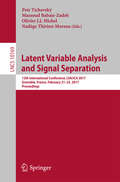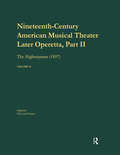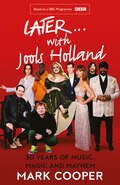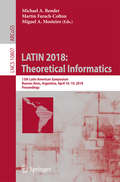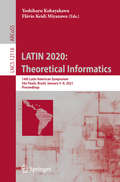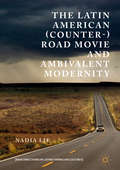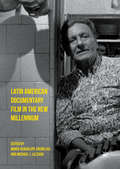- Table View
- List View
Lateness and Longing: On the Afterlife of Photography (Abakanowicz Arts and Culture Collection)
by George BakerHow a generation of women artists is transforming photography with analogue techniques. Beginning in the 1990s, a series of major artists imagined the expansion of photography, intensifying its ideas and effects while abandoning many of its former medium constraints. Simultaneous with this development in contemporary art, however, photography was moving toward total digitalization. Lateness and Longing presents the first account of a generation of artists—focused on the work of Zoe Leonard, Tacita Dean, Sharon Lockhart, and Moyra Davey—who have collectively transformed the practice of photography, using analogue technologies in a dissident way and radicalizing signifiers of older models of feminist art. All these artists have resisted the transition to the digital in their work. Instead—in what amounts to a series of feminist polemics—they return to earlier, incomplete, or unrealized moments in photography’s history, gravitating toward the analogue basis of photographic mediums. Their work announces that photography has become—not obsolete—but “late,” opened up by the potentially critical forces of anachronism. Through a strategy of return—of refusing to let go—the work of these artists proposes an afterlife and survival of the photographic in contemporary art, a formal lateness wherein photography finds its way forward through resistance to the contemporary itself.
Lateness and Longing: On the Afterlife of Photography (Abakanowicz Arts and Culture Collection)
by George BakerHow a generation of women artists is transforming photography with analogue techniques. Beginning in the 1990s, a series of major artists imagined the expansion of photography, intensifying its ideas and effects while abandoning many of its former medium constraints. Simultaneous with this development in contemporary art, however, photography was moving toward total digitalization. Lateness and Longing presents the first account of a generation of artists—focused on the work of Zoe Leonard, Tacita Dean, Sharon Lockhart, and Moyra Davey—who have collectively transformed the practice of photography, using analogue technologies in a dissident way and radicalizing signifiers of older models of feminist art. All these artists have resisted the transition to the digital in their work. Instead—in what amounts to a series of feminist polemics—they return to earlier, incomplete, or unrealized moments in photography’s history, gravitating toward the analogue basis of photographic mediums. Their work announces that photography has become—not obsolete—but “late,” opened up by the potentially critical forces of anachronism. Through a strategy of return—of refusing to let go—the work of these artists proposes an afterlife and survival of the photographic in contemporary art, a formal lateness wherein photography finds its way forward through resistance to the contemporary itself.
Latent Variable Analysis and Signal Separation: 14th International Conference, LVA/ICA 2018, Guildford, UK, July 2–5, 2018, Proceedings (Lecture Notes in Computer Science #10891)
by Yannick Deville Sharon Gannot Russell Mason Mark D. Plumbley Dominic WardThis book constitutes the proceedings of the 14th International Conference on Latent Variable Analysis and Signal Separation, LVA/ICA 2018, held in Guildford, UK, in July 2018.The 52 full papers were carefully reviewed and selected from 62 initial submissions. As research topics the papers encompass a wide range of general mixtures of latent variables models but also theories and tools drawn from a great variety of disciplines such as structured tensor decompositions and applications; matrix and tensor factorizations; ICA methods; nonlinear mixtures; audio data and methods; signal separation evaluation campaign; deep learning and data-driven methods; advances in phase retrieval and applications; sparsity-related methods; and biomedical data and methods.
Latent Variable Analysis and Signal Separation: 10th International Conference, LVA/ICA 2012, Tel Aviv, Israel, March 12-15, 2012, Proceedings (Lecture Notes in Computer Science #7191)
by Fabian Theis Andrzej Cichocki Arie Yeredor Michael ZibulevskyThis book constitutes the proceedings of the 10th International Conference on Latent Variable Analysis and Signal Separation, LVA/ICA 2012, held in Tel Aviv, Israel, in March 2012. The 20 revised full papers presented together with 42 revised poster papers, 1 keynote lecture, and 2 overview papers for the regular, as well as for the special session were carefully reviewed and selected from numerous submissions. Topics addressed are ranging from theoretical issues such as causality analysis and measures, through novel methods for employing the well-established concepts of sparsity and non-negativity for matrix and tensor factorization, down to a variety of related applications ranging from audio and biomedical signals to precipitation analysis.
Latent Variable Analysis and Signal Separation: 13th International Conference, LVA/ICA 2017, Grenoble, France, February 21-23, 2017, Proceedings (Lecture Notes in Computer Science #10169)
by Petr Tichavský Massoud Babaie-Zadeh Olivier J.J. Michel Nadège Thirion-MoreauThis book constitutes the proceedings of the 13th International Conference on Latent Variable Analysis and Signal Separation, LVA/ICA 2017, held in Grenoble, France, in Feburary 2017. The 53 papers presented in this volume were carefully reviewed and selected from 60 submissions. They were organized in topical sections named: tensor approaches; from source positions to room properties: learning methods for audio scene geometry estimation; tensors and audio; audio signal processing; theoretical developments; physics and bio signal processing; latent variable analysis in observation sciences; ICA theory and applications; and sparsity-aware signal processing.
Latent Variable Analysis and Signal Separation: 9th International Conference, LVA/ICA 2010, St. Malo, France, September 27-30, 2010, Proceedings (Lecture Notes in Computer Science #6365)
by Vincent Vigneron Vicente Zarzoso Eric Moreau Rémi Gribonval Emmanuel VincentThis book constitutes the proceedings of the 9th International Conference on Latent Variable Analysis and Signal Separation, LVA/ICA 2010, held in St. Malo, France, in September 2010.The 25 papers presented were carefully reviewed and selected from over hundred submissions. The papers collected in this volume demonstrate that the research activity in the field continues to gather theoreticians and practitioners, with contributions ranging range from abstract concepts to the most concrete and applicable questions and considerations. Speech and audio, as well as biomedical applications, continue to carry the mass of the considered applications. Unsurprisingly the concepts of sparsity and non-negativity, as well as tensor decompositions, have become predominant, reflecting the strongactivity on these themes in signal and image processing at large.
Latent Variable Analysis and Signal Separation: 12th International Conference, LVA/ICA 2015, Liberec, Czech Republic, August 25-28, 2015, Proceedings (Lecture Notes in Computer Science #9237)
by Emmanuel Vincent Arie Yeredor Zbyněk Koldovský Petr TichavskýThis book constitutes the proceedings of the 12th International Conference on Latent Variable Analysis and Signal Separation, LVA/ICS 2015, held in Liberec, Czech Republic, in August 2015. The 61 revised full papers presented – 29 accepted as oral presentations and 32 accepted as poster presentations – were carefully reviewed and selected from numerous submissions. Five special topics are addressed: tensor-based methods for blind signal separation; deep neural networks for supervised speech separation/enhancement; joined analysis of multiple datasets, data fusion, and related topics; advances in nonlinear blind source separation; sparse and low rank modeling for acoustic signal processing.
The Latent World of Architecture: Selected Essays
by Dalibor VeselyThis book features thirteen essays by the late architect, philosopher and teacher Dalibor Vesely (1934–2015). Vesely was a leading authority on philosophical hermeneutics and phenomenology in relation to architecture worldwide, and influenced a generation of thinkers, teachers and practitioners. This collection presents the full range of his writing, drawing primarily from the history of art and architecture, as well as philosophy, theology, anthropology and ecology, and spanning from early antiquity to modernism. It composes a multifaceted and globally relevant argument about the enduring cultural role of architecture and the significance of its history. The book, edited and introduced by Vesely’s teaching partner at Cambridge Peter Carl and former student Alexandra Stara, and with a foreword by David Leatherbarrow, brings to light new and hard-to-access material for those familiar with Vesely’s thought and, at the same time, offers a compelling introduction to his writing and its profound relevance for architecture and culture today.
The Latent World of Architecture: Selected Essays
by Dalibor VeselyThis book features thirteen essays by the late architect, philosopher and teacher Dalibor Vesely (1934–2015). Vesely was a leading authority on philosophical hermeneutics and phenomenology in relation to architecture worldwide, and influenced a generation of thinkers, teachers and practitioners. This collection presents the full range of his writing, drawing primarily from the history of art and architecture, as well as philosophy, theology, anthropology and ecology, and spanning from early antiquity to modernism. It composes a multifaceted and globally relevant argument about the enduring cultural role of architecture and the significance of its history. The book, edited and introduced by Vesely’s teaching partner at Cambridge Peter Carl and former student Alexandra Stara, and with a foreword by David Leatherbarrow, brings to light new and hard-to-access material for those familiar with Vesely’s thought and, at the same time, offers a compelling introduction to his writing and its profound relevance for architecture and culture today.
Later Byzantine Painting: Art, Agency, and Appreciation (Variorum Collected Studies)
by Robert S. NelsonWritten over nearly three decades, the fifteen essays involve the three a's of the title, art, agency, and appreciation. The first refers to the general subject matter of the book, Byzantine art, chiefly painting, of the twelfth through the fourteenth centuries, the second to its often human-like agency, and the last to its historical reception. Responding to different issues and perspectives that have animated art history and Byzantine studies in recent decades, the essays have wide theoretical range from art historical formalism, iconography, archaeology and its manuscript equivalent codicology, to statistics, patronage, narratology, and the histories of science and collecting. The series begins with art works themselves and with the imagery and iconography of church decoration and manuscript illumination, shifts to the ways that objects act in the world and affect their beholders, and concludes with more general appreciations of Byzantine art in case studies from the thirteenth century to the present.
Later Byzantine Painting: Art, Agency, and Appreciation (Variorum Collected Studies)
by Robert S. NelsonWritten over nearly three decades, the fifteen essays involve the three a's of the title, art, agency, and appreciation. The first refers to the general subject matter of the book, Byzantine art, chiefly painting, of the twelfth through the fourteenth centuries, the second to its often human-like agency, and the last to its historical reception. Responding to different issues and perspectives that have animated art history and Byzantine studies in recent decades, the essays have wide theoretical range from art historical formalism, iconography, archaeology and its manuscript equivalent codicology, to statistics, patronage, narratology, and the histories of science and collecting. The series begins with art works themselves and with the imagery and iconography of church decoration and manuscript illumination, shifts to the ways that objects act in the world and affect their beholders, and concludes with more general appreciations of Byzantine art in case studies from the thirteenth century to the present.
Later Operetta 2: the Highwayman, Music by Reginald DeKoven, Libretto by Harry B. Smith, 1897 (Nineteenth-Century American Musical Theater Series)
by Reginald De KovenThe most successful American-born composer of operetta at the end of the nineteenth century was Reginald de Koven. The work reprinted in this volume, The Highwayman, is arguably his best work, although he is better known for the earlier Robin Hoodwixh its evergreen wedding ballad "Oh Promise Me." (Robin Hood is available as a reprint in the 1990 volume American Opera and Music for the Stage, in the G.K. Hall series Three Centuries of American Music.) The editor of this volume, Orly Leah Krasner, is a leading scholar of de Koven’s music. She teaches at the City University of New York, and her Ph.D. dissertation, "Reginald de Koven (1859-1920) and American Comic Opera at the Turn of the Century," is also from that university. Her introduction places the work in the tenor of contemporary critical reaction, and lists the sources available for further study. The Highwayman is one of the few complete operettas of its era for which we are fortunate enough to have original performing materials in the composer’s own hand. As the penultimate volume (number 15) in this series, de Koven’s work of 1897 contrasts with two works of the previous year, Walter Damrosch’s opera The Scarlet Letter (volume 16) and John Philip Sousa’s operetta El Capitan (volume 14).
Later Operetta 2: the Highwayman, Music by Reginald DeKoven, Libretto by Harry B. Smith, 1897 (Nineteenth-Century American Musical Theater Series)
by Orly Leah KrasnerThe most successful American-born composer of operetta at the end of the nineteenth century was Reginald de Koven. The work reprinted in this volume, The Highwayman, is arguably his best work, although he is better known for the earlier Robin Hoodwixh its evergreen wedding ballad "Oh Promise Me." (Robin Hood is available as a reprint in the 1990 volume American Opera and Music for the Stage, in the G.K. Hall series Three Centuries of American Music.) The editor of this volume, Orly Leah Krasner, is a leading scholar of de Koven’s music. She teaches at the City University of New York, and her Ph.D. dissertation, "Reginald de Koven (1859-1920) and American Comic Opera at the Turn of the Century," is also from that university. Her introduction places the work in the tenor of contemporary critical reaction, and lists the sources available for further study. The Highwayman is one of the few complete operettas of its era for which we are fortunate enough to have original performing materials in the composer’s own hand. As the penultimate volume (number 15) in this series, de Koven’s work of 1897 contrasts with two works of the previous year, Walter Damrosch’s opera The Scarlet Letter (volume 16) and John Philip Sousa’s operetta El Capitan (volume 14).
Later ... With Jools Holland: 30 Years Of Music, Magic And Mayhem
by Mark Cooper’You never knew what you were going to be confronted with when you went on Later…’ Nick Cave ‘Later… is a voyage of discovery for us as well as the viewers’ Dave Grohl
LaTeX Cookbook
by Stefan KottwitzOver 100 hands-on recipes to quickly prepare LaTeX documents of various kinds to solve challenging tasks About This Book • Work with modern document classes, such as KOMA-Script classes • Explore the latest LaTeX packages, including TikZ, pgfplots, and biblatex • An example-driven approach to creating stunning graphics directly within LaTeX Who This Book Is For If you already know the basics of LaTeX and you like to get fast, efficient solutions, this is the perfect book for you. If you are an advanced reader, you can use this book's example-driven format to take your skillset to the next level. Some familiarity with the basic syntax of LaTeX and how to use the editor of your choice for compiling is required. What You Will Learn • Choose the right document class for your project to customize its features • Utilize fonts globally and locally • Frame, shape, arrange, and annotate images • Add a bibliography, a glossary, and an index • Create colorful graphics including diagrams, flow charts, bar charts, trees, plots in 2d and 3d, time lines, and mindmaps • Solve typical tasks for various sciences including math, physics, chemistry, electrotechnics, and computer science • Optimize PDF output and enrich it with meta data, annotations, popups, animations, and fill-in fields • Explore the outstanding capabilities of the newest engines and formats such as XeLaTeX, LuaLaTeX, and LaTeX3 In Detail LaTeX is a high-quality typesetting software and is very popular, especially among scientists. Its programming language gives you full control over every aspect of your documents, no matter how complex they are. LaTeX's huge amount of customizable templates and supporting packages cover most aspects of writing with embedded typographic expertise. With this book you will learn to leverage the capabilities of the latest document classes and explore the functionalities of the newest packages. The book starts with examples of common document types. It provides you with samples for tuning text design, using fonts, embedding images, and creating legible tables. Common document parts such as the bibliography, glossary, and index are covered, with LaTeX's modern approach. You will learn how to create excellent graphics directly within LaTeX, including diagrams and plots quickly and easily. Finally, you will discover how to use the new engines XeTeX and LuaTeX for advanced programming and calculating with LaTeX. The example-driven approach of this book is sure to increase your productivity. Style and approach This book guides you through the world of LaTeX based on over a hundred hands-on examples. These are explained in detail and are designed to take minimal time and to be self-compliant.
LATIN 2002: 5th Latin American Symposium, Cancun, Mexico, April 3-6, 2002, Proceedings (Lecture Notes in Computer Science #2286)
by Sergio RajsbaumThis book constitutes the refereed proceedings of the 5th International Symposium, Latin American Theoretical Informatics, LATIN 2002, held in Cancun, Mexico, in April 2002.The 44 revised full papers presented together with a tutorial and 7 abstracts of invited contributions were carefully reviewed and selected from a total of 104 submissions. The papers presented are devoted to a broad range of topics from theoretical computer science and mathematical foundations, with a certain focus on algorithmics and computations related to discrete structures.
LATIN 2018: 13th Latin American Symposium, Buenos Aires, Argentina, April 16-19, 2018, Proceedings (Lecture Notes in Computer Science #10807)
by Michael A. Bender Martín Farach-Colton Miguel A. MosteiroThis book constitutes the proceedings of the 13th Latin American Symposium on Theoretical Informatics, LATIN 2018, held in Buenos Aires, Argentina, in April 2018. The 63 papers presented in this volume were carefully reviewed and selected from 161 submissions. The Symposium is devoted to different areas in theoretical computer science, including, but not limited to: algorithms (approximation, online, randomized, algorithmic game theory, etc.), analytic combinatorics and analysis of algorithms, automata theory and formal languages, coding theory and data compression, combinatorial algorithms, combinatorial optimization, combinatorics and graph theory, complexity theory, computational algebra, computational biology, computational geometry, computational number theory, cryptology, databases and information retrieval, data structures, formal methods and security, Internet and the web, parallel and distributed computing, pattern matching, programming language theory, and random structures.
LATIN 2020: 14th Latin American Symposium, São Paulo, Brazil, January 5-8, 2021, Proceedings (Lecture Notes in Computer Science #12118)
by Yoshiharu Kohayakawa Flávio Keidi MiyazawaThis book constitutes the refereed proceedings of the 14th Latin American Symposium on Theoretical Informatics, LATIN 2020, held in Sao Paulo, Brazil, in January 2021. The 50 full papers presented in this book were carefully reviewed and selected from 136 submissions. The papers are grouped into these topics: approximation algorithms; parameterized algorithms; algorithms and data structures; computational geometry; complexity theory; quantum computing; neural networks and biologically inspired computing; randomization; combinatorics; analytic and enumerative combinatorics; graph theory.Due to the Corona pandemic the event was postponed from May 2020 to January 2021.
Latin America at Fin-de-Siècle Universal Exhibitions: Modern Cultures of Visuality (New Directions in Latino American Cultures)
by Alejandra UslenghiSpanning from the 1876 exposition in Philadelphia, through Paris 1889, and culminating in Paris 1900, this book examines how Argentina, Brazil, and Mexico forged the image of a modernizing Latin America at the moment of their insertion into the new visual economy of capitalism, as well as how their modern writers experienced and narrated these events by introducing new literary forms and modernizing literary language. Following these itineraries overseas and back, Uslenghi illuminates the contested, political, and transformative relations that emerged as images and material culture travelled from sites of production to those of exhibition, exchange, and consumption.
Latin American and Latinx Fashion Design Today - ¡Moda Hoy!
by Tanya Meléndez-Escalante Melissa Marra-AlvarezAccompanying a major exhibition at The Museum at FIT, Latin American and Latinx Fashion Design Today: ¡Moda Hoy! examines Latin American and Latinx fashion design from the past 20 years, asking “What is Latin American fashion design in the 21st century”?The book seeks to explore the sociohistorical influences and cultural dynamics that have propelled the development of the unique sartorial bricolage that is Latin American and Latinx fashion. Through a series of themes and topics favored by contemporary designers – including Indigenous heritage, art, sustainable design, politics, gender, elegance, and popular culture – it highlights established designers with a strong international presence, such as Isabel Toledo, Carolina Herrera, Rick Owens, Oscar de la Renta, Carla Fernández, and Gabriela Hearst. Accompanied by regional brands and emerging talents, and case studies that take an in-depth look into specific designers, and beautifully illustrated in full color throughout, Latin American and Latinx Fashion Design Today is essential reading for fashion enthusiasts who have an overlapping interest in Latin American studies, and all who appreciate the history and visual culture of fashion and Latin America.
Latin American and Latinx Fashion Design Today - ¡Moda Hoy!
Accompanying a major exhibition at The Museum at FIT, Latin American and Latinx Fashion Design Today: ¡Moda Hoy! examines Latin American and Latinx fashion design from the past 20 years, asking “What is Latin American fashion design in the 21st century”?The book seeks to explore the sociohistorical influences and cultural dynamics that have propelled the development of the unique sartorial bricolage that is Latin American and Latinx fashion. Through a series of themes and topics favored by contemporary designers – including Indigenous heritage, art, sustainable design, politics, gender, elegance, and popular culture – it highlights established designers with a strong international presence, such as Isabel Toledo, Carolina Herrera, Rick Owens, Oscar de la Renta, Carla Fernández, and Gabriela Hearst. Accompanied by regional brands and emerging talents, and case studies that take an in-depth look into specific designers, and beautifully illustrated in full color throughout, Latin American and Latinx Fashion Design Today is essential reading for fashion enthusiasts who have an overlapping interest in Latin American studies, and all who appreciate the history and visual culture of fashion and Latin America.
The Latin American (Counter-) Road Movie and Ambivalent Modernity
by Nadia LieThis book offers a comprehensive and systematic overview of the flourishing genre of the contemporary Latin American road movie, of which Diarios de motocicleta and Y tu mamá también are only the best-known examples. It offers the first systematic survey of the genre and explains why the road movie is key to contemporary Latin American cinema and society. Proposing the new category of “counter-road movie,” and paying special attention to the genre’s intricate relationship to modernity, Nadia Lie charts the variety of the road movie through films by both renowned and emerging filmmakers. The Latin American (Counter-) Road Movie and Ambivalent Modernity engages with ongoing debates on transnationalism and takes the reader along a wide range of topics, from exile to undocumented migration, from tourism to internally displaced people.
The Latin American (Counter-) Road Movie and Ambivalent Modernity
by Nadia LieThis book offers a comprehensive and systematic overview of the flourishing genre of the contemporary Latin American road movie, of which Diarios de motocicleta and Y tu mamá también are only the best-known examples. It offers the first systematic survey of the genre and explains why the road movie is key to contemporary Latin American cinema and society. Proposing the new category of “counter-road movie,” and paying special attention to the genre’s intricate relationship to modernity, Nadia Lie charts the variety of the road movie through films by both renowned and emerging filmmakers. The Latin American (Counter-) Road Movie and Ambivalent Modernity engages with ongoing debates on transnationalism and takes the reader along a wide range of topics, from exile to undocumented migration, from tourism to internally displaced people.
Latin American Documentary Film in the New Millennium
by María Guadalupe Arenillas Michael J. LazzaraNearly two decades into the new millennium, Latin American documentary film is experiencing renewed vibrancy and visibility on the global stage. While elements of the combative, politicized cinema of the 1960s and 1970s remain, the region’s production has become increasingly subjective, reflexive, and experimental, though perhaps no less political. At the same time, Latin American filmmakers both respond to and shape global tendencies in the genre. This book highlights the richness and heterogeneity of Latin American documentary film, surveys a broad range of national contexts, styles, and practices, and expands current debates on the genre. Thematic sections address the “subjective turn” of the 1990s and 2000s and the move beyond it; the ethics of the encounter between the filmmaker and the subject/object of his or her gaze; and the performance of truth and memory, a particularly urgent topic as Latin American countries have transitioned from dictatorship to democracy.
Latin American Film Industries (International Screen Industries)
by Tamara L. FalicovFilm production in Latin America is as old as cinema itself, but local film industries have always been in a triangulated relationship with Hollywood and European cinema. This book situates Latin American film industries within the global circulation of film production, exhibition and distribution, charting the changes that the industries have undergone from the sound era to the present day. Focusing in particular on Argentina, Brazil and Mexico, Tamara Falicov examines commonalities among Latin American film industries, such as the challenges of procuring funding, competition from Hollywood, state funding battles, and the fickle nature of audiences, as well as censorship issues, competition from television, and the transnational nature of Latin American film. She addresses production, exhibition, and distribution contexts and financing and co-production with Europe and the United States, as well as the role of film festivals in funding and circulating films both within and outside of Latin America. Newer trends such as the revival of protectionist measures like the screen quota are framed in contrast to the U.S.'s push for trade policy liberalization and issues of universal concern such as film piracy, and new technologies and the role of television in helping and hindering Latin American cinema.



